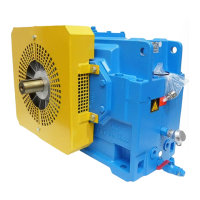29 / 109
BA 5846 en 05/2015
5.4 Lubrication
5.4.1 Forcefeed lubrication
In case of high input speeds or high peripheral speeds at the toothed systems, the splash lubrication can,
depending on the order, be supplemented by or replaced with a forcefeed lubrication.
In case of forcefeed lubrication the bearings and/or teeth situated higher than the oil level are adequately
supplied with oil by way of pipework.
The following configurations are possible:
─ External oilsupply system (fitted separately, see item 5.8.3).
Note
In case of gear units with oilsupply system, before starting the unit up all monitors must be connected
so as to be ready for operation.
2)
“x” bar
1)
1
4
2PE
-S*
P
X
1)
Pressure in accordance with values specified in the order-specific
documentation.
2)
To be connected as opening contact or maker contact, as required.
Note
When operating and servicing the components of the oilsupply system, observe the operating
instructions of the components.
For technical data and control information, refer to the data sheet and/or the list of equipment.
For a detailed illustration of the gear unit and the oilsupply system, refer to the drawings in the gearunit
documentation.
5.5 Shaft bearings
All shafts are fitted in rolling bearings.
5.6 Shaft seal
Radial shaftsealing rings and Taconite seals at the shaft outlets prevent oil from escaping from, or dirt from
entering into the gear unit.
5.6.1 Radial shaftsealing rings
Radial shaftsealing rings are the standard type of seal. Radial shaftsealing rings seal with contact and
are fitted with an additional dust lip to protect the actual sealing lip from exterior contamination.
NOTICE
Material damage
Destruction of the radial shaftsealing ring possible through high dust concentration.
Do not use radial shaftsealing ring in an environment with high dust concentration.
Fig. 10: Radial shaftsealing ring

